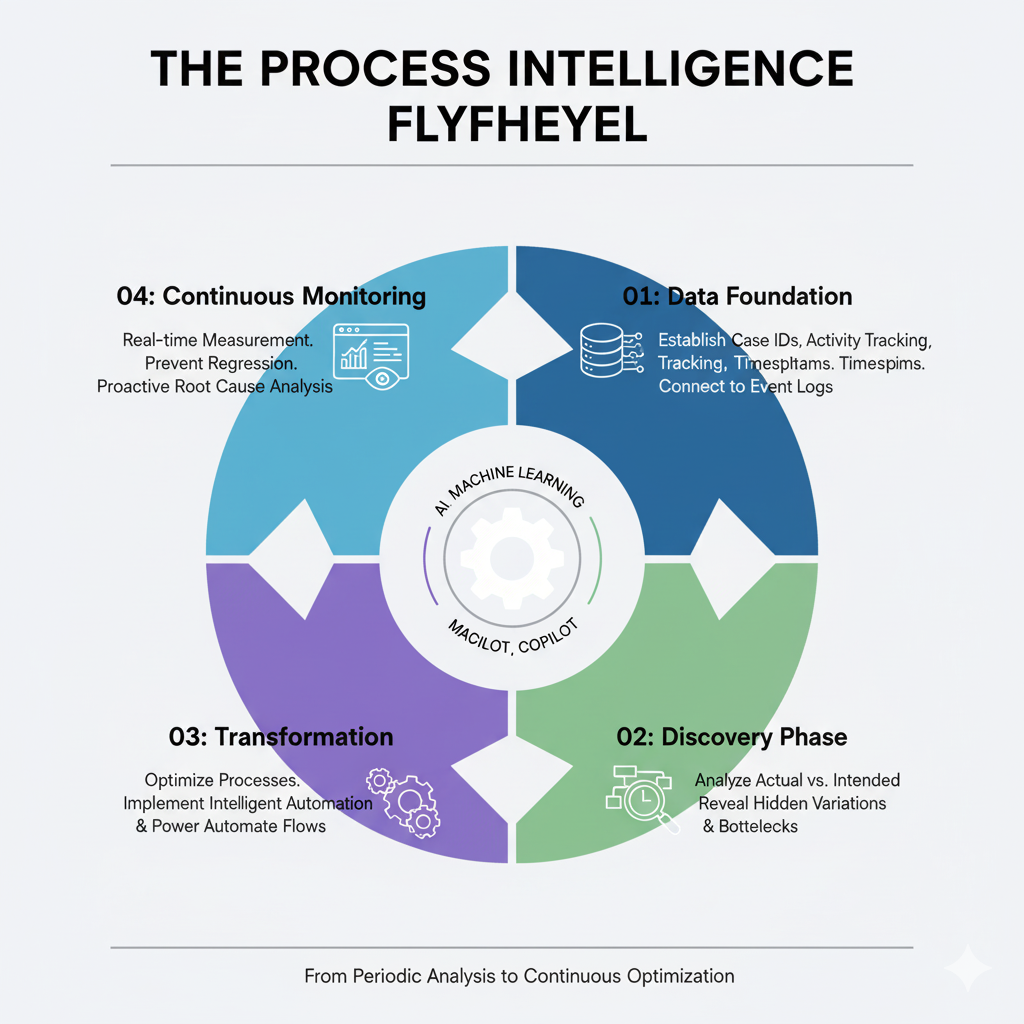PPCC: From chaos to clarity - The transformative power of process mining in the agentic era

Executive Summary: From Operational Chaos to Intelligent Automation
Today's enterprise leaders face an unprecedented challenge: implementing AI and automation technologies on top of poorly understood business processes. The result? Multiplied chaos instead of optimized efficiency. However, forward-thinking organizations are discovering that process intelligence—the evolution of traditional process mining enhanced with AI capabilities—provides the foundation for successful digital transformation.
At its core, every business operation is fundamentally a process. Whether managing daily workflows or executing strategic initiatives, organizations that master process intelligence gain competitive advantages through data-driven decision making, eliminating operational friction, and implementing automation that amplifies efficiency rather than confusion.
The Hidden Reality of Enterprise Processes: Why Traditional Approaches Fail
Most organizations operate under dangerous assumptions about their processes. What appears as a straightforward purchase-and-pay workflow with clean boxes for purchasing, logistics, and finance often reveals extraordinary complexity when examined through process mining. A recent analysis of emergency medical services—handling 200,000 yearly calls across 1,000+ coverage divisions—discovered over 1,000 process variations despite having only 13 core activities.
This complexity manifests in three critical levels of operational chaos:
Level 1: Visibility Crisis - Teams make decisions based on assumptions rather than data-driven insights, turning strategic planning into educated guesswork.
Level 2: Data Friction - Departments execute procedures in isolation without understanding cross-functional impacts, creating organizational silos that prevent optimization.
Level 3: Optimization Barriers - Organizations implement AI and automation on broken processes, exponentially multiplying inefficiencies instead of creating streamlined operations.
Measurable Impact: Real-World Process Intelligence Success Stories
Smart Citizen Services: Serving 1.5 Million Citizens Across 17 Municipalities
A Netherlands-based smart citizen services organization transformed their operations by implementing process intelligence across elections management, citizen feedback systems, and permit tracking. Results included:
- 10-minute audit processing time (previously requiring hours or days)
- 20% improvement in permit processing efficiency
- Continuous monitoring capabilities for all citizen interactions
- Enhanced transparency across 17 municipal jurisdictions
IT Service Management: 100,000+ Annual Tickets Optimized
An enterprise IT organization processing over 100,000 tickets annually applied process mining to incident management workflows, achieving:
- 15% reduction in mean time to resolve incidents
- Daily data regression capabilities for continuous improvement
- Real-time visibility into resolution patterns and bottlenecks
- Automated escalation procedures based on process intelligence
Life-Saving Process Optimization: Emergency Medical Services
The most compelling example involves paramedics operations where process optimization directly impacts human lives. By applying process intelligence to emergency response procedures—from 911 calls through dispatch, arrival, treatment, and transport—the organization optimized:
- Time-to-dispatch policies for faster emergency response
- Process deviation identification to maintain quality standards
- Response procedure streamlining across geographic coverage areas
- Critical performance metrics tracking in real-time
The outcome extends beyond operational efficiency to improved patient satisfaction, enhanced paramedic job performance, and ultimately more lives saved through optimized response times.
The Next Frontier: Object-Centric Process Mining and Agentic AI
Traditional process mining approaches force complex, multi-object processes into simplified linear flows, often losing critical context and creating misleading process representations. The next generation of process intelligence embraces two revolutionary innovations:
Object-Centric Process Mining: Preserving Process Complexity
Rather than flattening complex workflows into artificial case IDs, object-centric process mining maintains natural relationships between multiple process objects. In healthcare scenarios involving patients, treatments, room assignments, and blood tests, this approach reveals true process interdependencies without creating artificial loops that don't exist in reality.
Real-world healthcare analysis demonstrates this power: examining 112 patients through object-centric mining reveals that room assignment to patient discharge averages five days, while blood test processing requires eight hours from admission. This granular visibility enables targeted improvements that directly impact patient care quality and operational efficiency.
Agentic AI: Self-Healing Processes and Accelerated Intelligence
The emergence of "agentic process mining" represents a paradigm shift toward self-correcting, adaptive processes. This approach integrates AI agents throughout the process intelligence pipeline to achieve two critical objectives:
Self-Healing Processes: Enterprise applications embedded with process intelligence that automatically detect deviations, identify root causes, and trigger corrective actions without human intervention.
Accelerated Time-to-Value: Traditional process mining implementations requiring weeks or months now compress to hours or days through AI-powered analysis and insight generation.
Technical Architecture for Process Intelligence Success
Modern process intelligence implementations rest on three foundational pillars:
1. Universal Process Intelligence Interface
Standardized access to process mining capabilities—including bottleneck analysis, root cause identification, and process simulation—that integrates seamlessly across enterprise technology stacks.
2. Conversational Process Intelligence
Natural language interactions with process data that eliminate the traditional gap between complex analysis and actionable business insights. Business users query process performance without requiring deep technical expertise, while automation developers access real-world process behavior during application design.
3. Perpetual Process Analysis
Always-on intelligent systems that continuously monitor process performance, proactively identify optimization opportunities, and perform root cause analysis rather than simply reporting symptoms like SLA breaches.
Implementation Strategy: The Process Intelligence Flywheel
Successful process intelligence deployment follows a cyclical methodology that ensures continuous improvement:
- Data Foundation: Establish case IDs, activity tracking, and comprehensive timestamp logging across all process touchpoints
- Discovery Phase: Analyze actual process execution versus intended workflows, revealing hidden variations and bottlenecks
- Transformation: Apply insights to optimize processes before implementing automation solutions
- Continuous Monitoring: Implement ongoing measurement and adjustment to prevent regression to previous inefficiencies
This flywheel approach transforms process mining from periodic analysis into continuous optimization capability.
The Competitive Imperative: Why Process Intelligence Cannot Wait
Organizations implementing AI and automation without process intelligence foundations risk amplifying existing inefficiencies at machine speed. However, enterprises that establish process intelligence capabilities first gain:
- Data-driven decision making replacing assumption-based planning
- Cross-functional visibility eliminating departmental silos
- Intelligent automation that multiplies efficiency rather than chaos
- Continuous improvement capabilities as organizational competencies
- Competitive advantages through operational excellence
Future Outlook: Toward Self-Managing Enterprise Processes
The convergence of object-centric process mining and agentic AI signals a fundamental shift toward intelligent, self-managing enterprise processes. Organizations adopting these capabilities gain unprecedented process visibility while dramatically accelerating improvement identification and implementation.
As these technologies mature, enterprise applications will automatically optimize themselves based on real-time process intelligence, eliminating traditional delays between problem identification and corrective action. The result: more resilient, efficient, and adaptive business operations that continuously evolve to meet changing requirements.
For automation companies and process improvement professionals, these innovations represent opportunities to move beyond reactive analysis toward proactive optimization. The question isn't whether these capabilities will transform enterprise operations, but how quickly organizations will adopt them to gain competitive advantage.
The future belongs to enterprises with self-healing, adaptive processes powered by embedded process intelligence—representing the next frontier in automation and operational excellence.
Ready to transform your organization's processes with intelligent automation? Discover how process intelligence can accelerate your digital transformation initiatives and deliver measurable business results.
Executive Summary: From Operational Chaos to Intelligent Automation
Today's enterprise leaders face an unprecedented challenge: implementing AI and automation technologies on top of poorly understood business processes. The result? Multiplied chaos instead of optimized efficiency. However, forward-thinking organizations are discovering that process intelligence—the evolution of traditional process mining enhanced with AI capabilities—provides the foundation for successful digital transformation.
At its core, every business operation is fundamentally a process. Whether managing daily workflows or executing strategic initiatives, organizations that master process intelligence gain competitive advantages through data-driven decision making, eliminating operational friction, and implementing automation that amplifies efficiency rather than confusion.
The Hidden Reality of Enterprise Processes: Why Traditional Approaches Fail
Most organizations operate under dangerous assumptions about their processes. What appears as a straightforward purchase-and-pay workflow with clean boxes for purchasing, logistics, and finance often reveals extraordinary complexity when examined through process mining. A recent analysis of emergency medical services—handling 200,000 yearly calls across 1,000+ coverage divisions—discovered over 1,000 process variations despite having only 13 core activities.
This complexity manifests in three critical levels of operational chaos:
Level 1: Visibility Crisis - Teams make decisions based on assumptions rather than data-driven insights, turning strategic planning into educated guesswork.
Level 2: Data Friction - Departments execute procedures in isolation without understanding cross-functional impacts, creating organizational silos that prevent optimization.
Level 3: Optimization Barriers - Organizations implement AI and automation on broken processes, exponentially multiplying inefficiencies instead of creating streamlined operations.
Measurable Impact: Real-World Process Intelligence Success Stories
Smart Citizen Services: Serving 1.5 Million Citizens Across 17 Municipalities
A Netherlands-based smart citizen services organization transformed their operations by implementing process intelligence across elections management, citizen feedback systems, and permit tracking. Results included:
- 10-minute audit processing time (previously requiring hours or days)
- 20% improvement in permit processing efficiency
- Continuous monitoring capabilities for all citizen interactions
- Enhanced transparency across 17 municipal jurisdictions
IT Service Management: 100,000+ Annual Tickets Optimized
An enterprise IT organization processing over 100,000 tickets annually applied process mining to incident management workflows, achieving:
- 15% reduction in mean time to resolve incidents
- Daily data regression capabilities for continuous improvement
- Real-time visibility into resolution patterns and bottlenecks
- Automated escalation procedures based on process intelligence
Life-Saving Process Optimization: Emergency Medical Services
The most compelling example involves paramedics operations where process optimization directly impacts human lives. By applying process intelligence to emergency response procedures—from 911 calls through dispatch, arrival, treatment, and transport—the organization optimized:
- Time-to-dispatch policies for faster emergency response
- Process deviation identification to maintain quality standards
- Response procedure streamlining across geographic coverage areas
- Critical performance metrics tracking in real-time
The outcome extends beyond operational efficiency to improved patient satisfaction, enhanced paramedic job performance, and ultimately more lives saved through optimized response times.
The Next Frontier: Object-Centric Process Mining and Agentic AI
Traditional process mining approaches force complex, multi-object processes into simplified linear flows, often losing critical context and creating misleading process representations. The next generation of process intelligence embraces two revolutionary innovations:
Object-Centric Process Mining: Preserving Process Complexity
Rather than flattening complex workflows into artificial case IDs, object-centric process mining maintains natural relationships between multiple process objects. In healthcare scenarios involving patients, treatments, room assignments, and blood tests, this approach reveals true process interdependencies without creating artificial loops that don't exist in reality.
Real-world healthcare analysis demonstrates this power: examining 112 patients through object-centric mining reveals that room assignment to patient discharge averages five days, while blood test processing requires eight hours from admission. This granular visibility enables targeted improvements that directly impact patient care quality and operational efficiency.
Agentic AI: Self-Healing Processes and Accelerated Intelligence
The emergence of "agentic process mining" represents a paradigm shift toward self-correcting, adaptive processes. This approach integrates AI agents throughout the process intelligence pipeline to achieve two critical objectives:
Self-Healing Processes: Enterprise applications embedded with process intelligence that automatically detect deviations, identify root causes, and trigger corrective actions without human intervention.
Accelerated Time-to-Value: Traditional process mining implementations requiring weeks or months now compress to hours or days through AI-powered analysis and insight generation.
Technical Architecture for Process Intelligence Success
Modern process intelligence implementations rest on three foundational pillars:
1. Universal Process Intelligence Interface
Standardized access to process mining capabilities—including bottleneck analysis, root cause identification, and process simulation—that integrates seamlessly across enterprise technology stacks.
2. Conversational Process Intelligence
Natural language interactions with process data that eliminate the traditional gap between complex analysis and actionable business insights. Business users query process performance without requiring deep technical expertise, while automation developers access real-world process behavior during application design.
3. Perpetual Process Analysis
Always-on intelligent systems that continuously monitor process performance, proactively identify optimization opportunities, and perform root cause analysis rather than simply reporting symptoms like SLA breaches.
Implementation Strategy: The Process Intelligence Flywheel
Successful process intelligence deployment follows a cyclical methodology that ensures continuous improvement:
- Data Foundation: Establish case IDs, activity tracking, and comprehensive timestamp logging across all process touchpoints
- Discovery Phase: Analyze actual process execution versus intended workflows, revealing hidden variations and bottlenecks
- Transformation: Apply insights to optimize processes before implementing automation solutions
- Continuous Monitoring: Implement ongoing measurement and adjustment to prevent regression to previous inefficiencies
This flywheel approach transforms process mining from periodic analysis into continuous optimization capability.
The Competitive Imperative: Why Process Intelligence Cannot Wait
Organizations implementing AI and automation without process intelligence foundations risk amplifying existing inefficiencies at machine speed. However, enterprises that establish process intelligence capabilities first gain:
- Data-driven decision making replacing assumption-based planning
- Cross-functional visibility eliminating departmental silos
- Intelligent automation that multiplies efficiency rather than chaos
- Continuous improvement capabilities as organizational competencies
- Competitive advantages through operational excellence
Future Outlook: Toward Self-Managing Enterprise Processes
The convergence of object-centric process mining and agentic AI signals a fundamental shift toward intelligent, self-managing enterprise processes. Organizations adopting these capabilities gain unprecedented process visibility while dramatically accelerating improvement identification and implementation.
As these technologies mature, enterprise applications will automatically optimize themselves based on real-time process intelligence, eliminating traditional delays between problem identification and corrective action. The result: more resilient, efficient, and adaptive business operations that continuously evolve to meet changing requirements.
For automation companies and process improvement professionals, these innovations represent opportunities to move beyond reactive analysis toward proactive optimization. The question isn't whether these capabilities will transform enterprise operations, but how quickly organizations will adopt them to gain competitive advantage.
The future belongs to enterprises with self-healing, adaptive processes powered by embedded process intelligence—representing the next frontier in automation and operational excellence.
Ready to transform your organization's processes with intelligent automation? Discover how process intelligence can accelerate your digital transformation initiatives and deliver measurable business results.
Related Blog Posts

PPCC Keynote: Microsoft Fabric: The Game-Changing Platform Transforming Enterprise Data Culture for the AI Era

PPCC: The Process Intelligence Revolution: How Modern Enterprises Are Transforming Operations with AI-Powered Process Mining


.jpg)